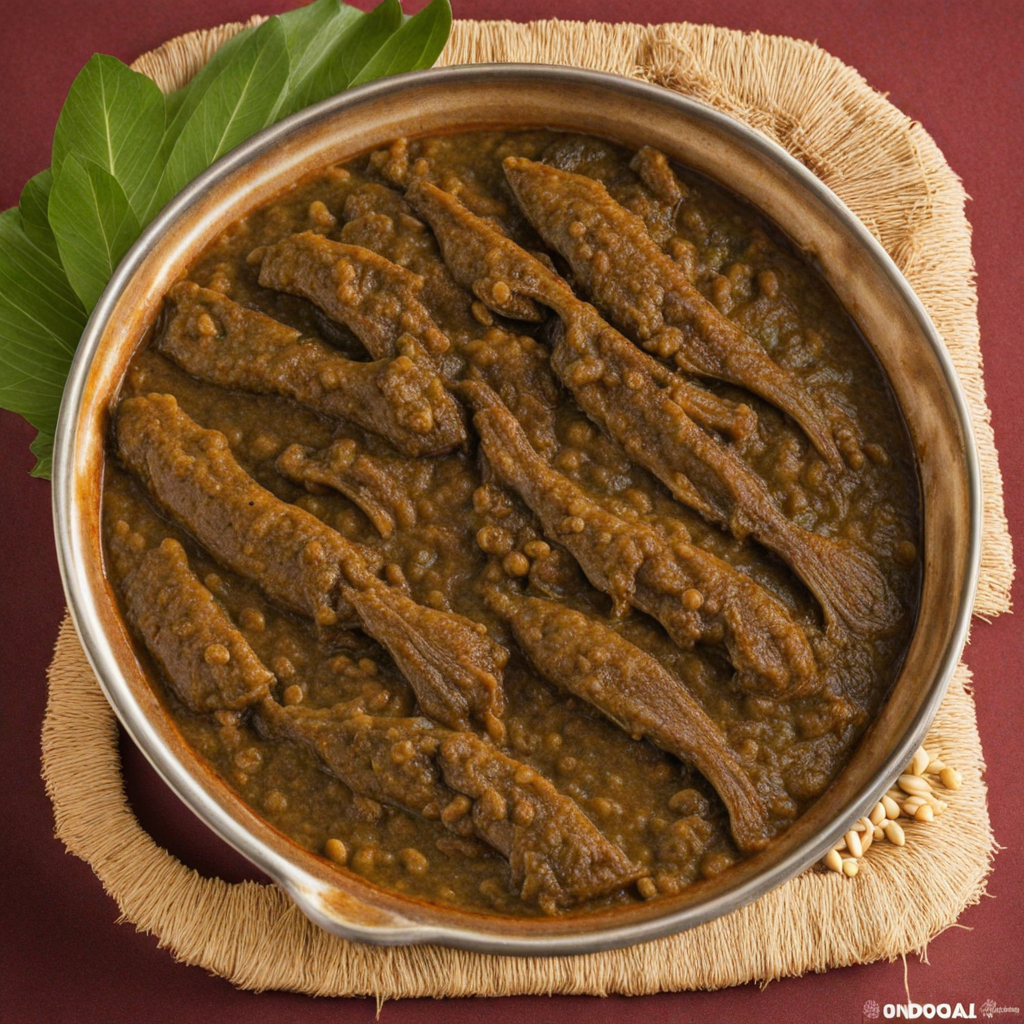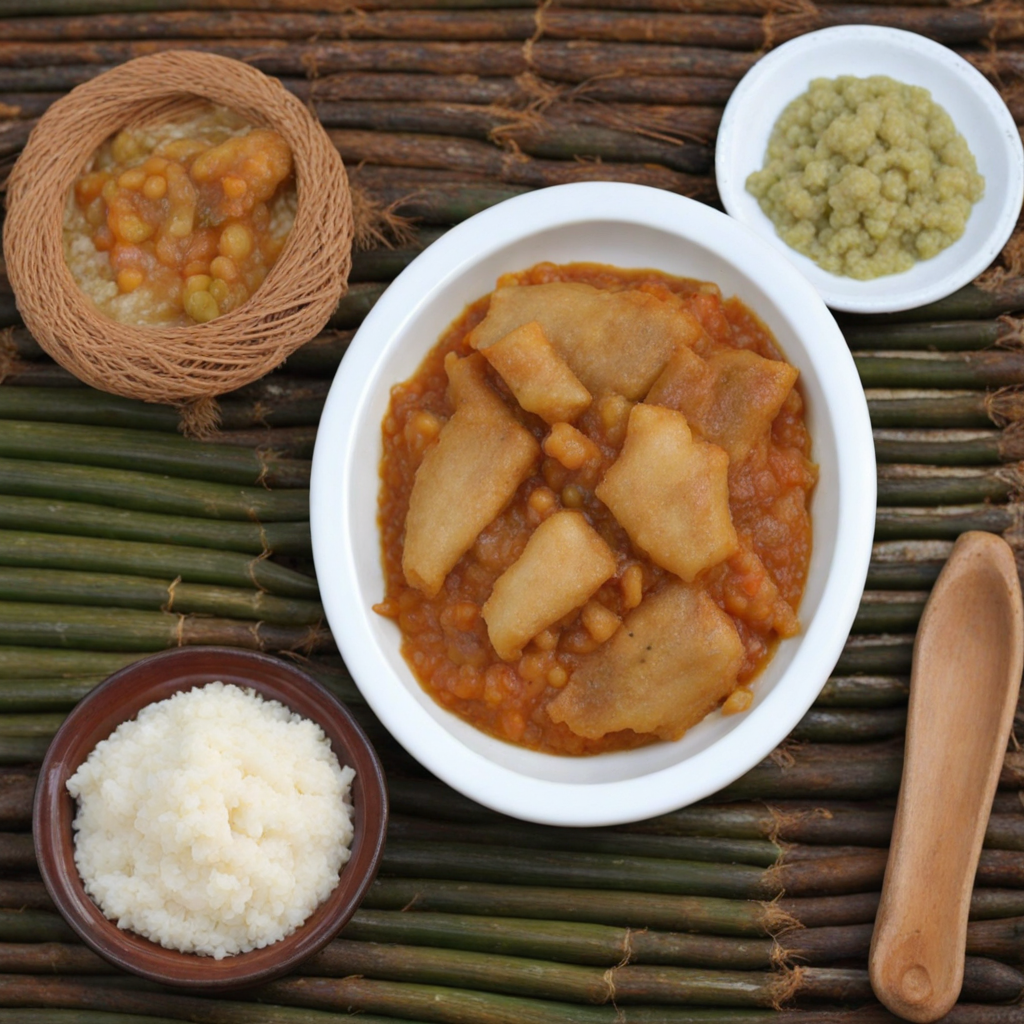Ifisashi
Ifisashi is a traditional Zambian dish that beautifully exemplifies the country’s culinary heritage. At its core, Ifisashi consists of finely ground peanuts or peanut butter combined with a variety of leafy greens, such as pumpkin leaves or spinach. The dish is often prepared by simmering these ingredients together, allowing the rich, nutty flavor of the peanuts to meld with the earthy, vibrant greens. The result is a creamy, savory mixture that is not only satisfying but also packed with nutrition, making it a staple in many Zambian households. The preparation of Ifisashi can vary from region to region, with some variations incorporating other vegetables like tomatoes and onions to enhance the flavor profile. The dish is typically seasoned with salt and sometimes a touch of chili for added heat, aligning with the Zambian preference for bold yet balanced flavors. It is often served as a side dish, complementing staple foods such as nshima, a thick porridge made from maize meal, which acts as the perfect base to soak up the delicious sauce. Ifisashi is more than just a meal; it embodies a sense of community and connection to Zambian culture. The simplicity of its ingredients speaks to the resourcefulness of local cuisine, where fresh, seasonal produce is celebrated. Whether enjoyed at a family gathering or in a bustling market, Ifisashi offers a warm, hearty taste of Zambia that invites food lovers to explore and appreciate its unique flavors.
How It Became This Dish
The History of Ifisashi: A Culinary Gem from Zambia Ifisashi is a traditional Zambian dish that embodies the rich culinary heritage of the country. As a staple in Zambian households, it is more than just food; it represents the community, culture, and the natural bounty of the land. This dish, made primarily with vegetables and groundnuts (peanuts), has a fascinating history that reflects the agricultural practices, social customs, and nutritional needs of the Zambian people throughout the ages. #### Origins and Ingredients The roots of Ifisashi can be traced back to the early agricultural societies in Zambia, where communities relied on subsistence farming to meet their dietary needs. The main ingredients of Ifisashi—vegetables such as pumpkin leaves, sweet potato leaves, or other indigenous greens, combined with groundnuts—are emblematic of the crops that have been cultivated in the region for centuries. Groundnuts, in particular, have a long-standing history in Africa as a source of protein and healthy fats. Historically, Zambia has been home to various ethnic groups, each with their own agricultural practices and culinary traditions. The Bemba people, one of the prominent ethnic groups in Zambia, are often credited with the popularization of Ifisashi. Traditionally, the dish was prepared during communal gatherings and celebrations, serving as a symbol of unity and sharing among families and communities. #### Cultural Significance Ifisashi is not merely a dish; it holds significant cultural importance in Zambian society. The preparation of Ifisashi is often a communal activity, bringing together family members and neighbors. This practice fosters a sense of community and reinforces social bonds. The act of cooking together, sharing recipes, and passing down culinary knowledge from one generation to another is a vital aspect of Zambian culture. Moreover, Ifisashi is often served during important ceremonies and festivities, such as weddings, harvest celebrations, and religious gatherings. It is commonly accompanied by nshima, a staple maize porridge that serves as the base of most Zambian meals. The combination of Ifisashi and nshima creates a nutritious meal that is both satisfying and rich in essential nutrients, reflecting the Zambian philosophy of food as a source of strength and nourishment. #### Nutritional Value and Sustainability The nutritional profile of Ifisashi is another reason for its enduring popularity. The dish is rich in vitamins, minerals, and protein, making it a wholesome choice for families. The use of local leafy greens provides essential nutrients, while the groundnuts add a source of protein and healthy fats. In a country where food security has often been a concern, Ifisashi represents a sustainable way to utilize local resources effectively. The dish's adaptability is also a key factor in its longevity. Depending on seasonal availability, Zambians have historically modified the recipe to incorporate different vegetables, ensuring that Ifisashi remains a versatile staple. This flexibility has allowed Ifisashi to evolve while maintaining its core identity, enabling it to be enjoyed across various regions of Zambia. #### Evolution Over Time As Zambia has undergone significant social and economic changes, the preparation and consumption of Ifisashi have also evolved. The introduction of modern cooking methods and the influence of globalization have led to variations in the dish. In urban areas, for instance, Ifisashi might be prepared with more convenience-oriented ingredients or served in restaurants that cater to both local and international tastes. Despite these changes, the essence of Ifisashi remains intact. Many families continue to prepare it using traditional methods, preserving the cultural heritage associated with the dish. The use of fresh, locally sourced ingredients has become increasingly popular as awareness of food sustainability grows. This movement has rekindled interest in traditional recipes and cooking practices, leading to a renaissance of Zambian cuisine. #### Ifisashi in Contemporary Zambia Today, Ifisashi is celebrated not only as a beloved traditional dish but also as a symbol of Zambian identity. Food festivals, cultural events, and culinary competitions often feature Ifisashi, showcasing its versatility and importance in Zambian cuisine. Chefs and home cooks alike experiment with new variations, incorporating modern flavors while respecting the traditional roots of the dish. The Zambian diaspora has also played a crucial role in promoting Ifisashi beyond the borders of the country. Zambians living abroad often recreate the dish as a way to connect with their heritage, sharing it with friends and family from different cultural backgrounds. This has helped introduce Ifisashi to a broader audience, allowing people from various cultures to appreciate Zambian flavors and cooking techniques. #### The Future of Ifisashi As Zambia continues to navigate the complexities of modernization and globalization, the future of Ifisashi remains bright. Initiatives focused on promoting local cuisine and sustainable agriculture are gaining traction, encouraging younger generations to embrace their culinary heritage. Educational programs that teach traditional cooking methods and the nutritional benefits of local ingredients are vital in ensuring that Ifisashi and other traditional dishes remain relevant. Moreover, the growing interest in plant-based diets and healthy eating aligns with the qualities of Ifisashi. As more people seek nutritious, sustainable food options, this traditional dish stands poised to regain its status as a staple not only in Zambia but also in the global culinary landscape. Conclusion In conclusion, Ifisashi is more than just a dish; it is a testament to Zambia's agricultural heritage, cultural practices, and communal spirit. Its origins reflect the resourcefulness of Zambian communities, while its cultural significance underscores the importance of food in fostering social connections. As the world continues to evolve, Ifisashi serves as a bridge between the past and the future, reminding us of the value of tradition, sustainability, and community in our culinary experiences. Through its rich history and adaptability, Ifisashi remains an enduring symbol of Zambian identity, nourishing both body and soul.
You may like
Discover local flavors from Zambia







